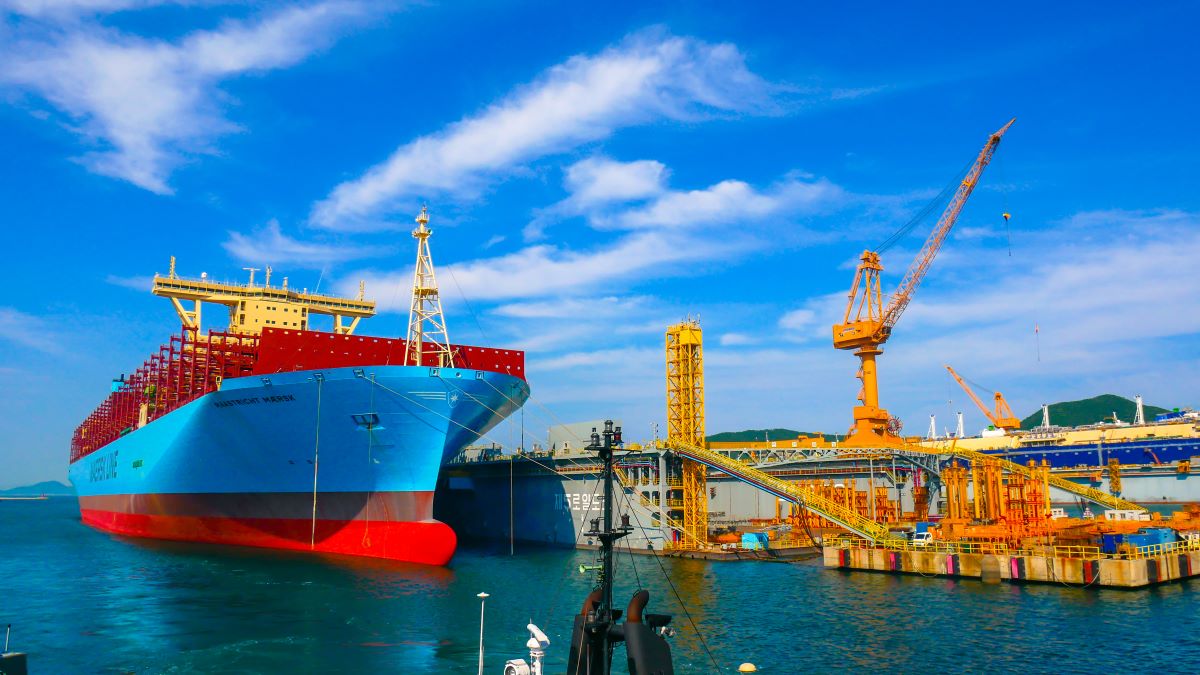The shipbuilding industry in South Korea has long been a global powerhouse, recognised for its technological expertise and high-value production. However, recent data shows a shift in the global market landscape, with China gaining momentum. Despite a dip in its overall market share, South Korea remains a leader in key sectors like LNG (liquefied natural gas) and LPG (liquefied petroleum gas) carriers, a cornerstone of the industry’s future.
South Korea and China lead the industry
In recent years, the global shipbuilding industry has been dominated by Asian players, mainly South Korea and China. According to a report by UK-based Clarkson Research, China accounted for approximately 71% of global shipbuilding orders based on Compensated Gross Tonnage (CGT) in 2024, marking a significant surge. In contrast, South Korea’s market share dropped to 17%, widening the gap between the two nations from 40 percentage points in 2023 to 54 percentage points in 2024. Despite an increase in total orders, it is South Korea’s lowest level in eight years. Europe accounts for 6% and Japan for 4% of the global order book, according to Clarkson’s data.
China’s dominance stems from its ability to produce high-volume at lower cost. According to a study by ING Think, labour costs in China are about 50% less compared to Korea and Japan. In total, labour costs comprise more than 20% of production costs. Moreover, China is also the world’s cheapest steel manufacturer, making for competitive prices on that end.
South Korea to focus on smart, clean shipbuilding tech
While South Korea’s overall market share has declined, it leads in efficiency, having the highest ratio of shipbuilding per yard, and value. “Most of the orders received by Korean shipbuilders are for high-value vessels such as LNG carriers, LPG carriers, and VLCCs, and they come from reliable shipowners,” says ING’s Min Joo Kang, Senior Economist, South Korea and Japan.
Korean shipbuilders hold a dominant 93% share of the LPG carrier market. China, on the other hand, has experienced the strongest growth in exports of motor container ships over the last two years. “This is a segment that is not the primary focus of Korean and Japanese shipbuilders,” says Kang.
South Korea’s focus on eco-friendly technology and adherence to International Maritime Organization (IMO) regulations positions it as a leader in sustainable shipbuilding. Companies like Hyundai Heavy Industries and Samsung Heavy Industries are at the forefront of innovation, developing advanced LNG and dual-fuel carriers to meet growing global demand.
The government is also supporting the shipbuilding industry by investing $1.44 bn over the next 10 years to collaborate with businesses in developing smart and clean energy technologies. In addition, international collaborations, for example with Norway to develop eco-friendly and smart vessels, strengthen the ambitions further.
Rising players in Asia’s shipbuilding industry
While China, South Korea and Japan currently account for more than 90% of the global shipbuilding industry, other Asian nations like Vietnam, the Philippines, and India are emerging as potential players with significant growth opportunities, the ING study highlights. However, barriers to entry remain high, as shipbuilding demands substantial capital, skilled labour, and often government support to compete with the established leaders.
Over the past decade, Vietnam’s shipbuilding industry has grown tenfold and is projected to maintain a compound annual growth rate (CAGR) of 6% from 2023 to 2032. The country is actively pursuing international cooperations, such as the joint shipyard between Hyundai Mipo and Vietnam’s Shipbuilding Industry Corporation (SBIC), which has grown into Southeast Asia’s largest shipyard.
India aims to become a top 10 shipbuilding nation by 2030. The government has launched key initiatives, such as the Financial Assistance Policy and infrastructure grants, to attract investment and reduce dependence on foreign shipping lines.
Looking ahead, Asia is in a good position to further lead the shipbuilding industry. ING names three factors: 1) The region’s central role in global trade, driven by rising intra-Asia trade flows, 2) Affordable yet skilled labour across emerging markets like Vietnam and the Philippines and 3) Government-backed strategies to support shipbuilding growth in countries such as India.
“The current upcycle in shipbuilding is poised to offer numerous opportunities for both emerging and established players,” says Kang. “Despite its cyclical nature, which inevitably brings future downturns, shipbuilders have demonstrated resilience and adaptability in managing past challenges. It is evident that shipbuilding will continue to be a significant growth driver in Asia.”


 Australia
Australia China
China India
India Indonesia
Indonesia Japan
Japan Malaysia
Malaysia Philippines
Philippines Singapore
Singapore South Korea
South Korea Taiwan
Taiwan Thailand
Thailand Vietnam
Vietnam






